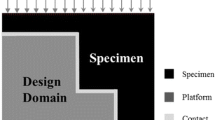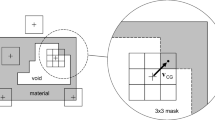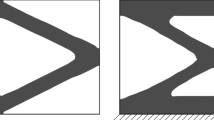Abstract
This paper presents a density-based topology optimization approach to design easy-removal support structures for additive manufacturing (AM). First, a multi-field structural parameterization is proposed for topology optimization by considering AM filtering technique that ensures the physical design being self-support. An easy-removal constraint is developed to generate porous structural patterns in the contact region between the support structures and its surroundings. An improved formulation is further proposed to prevent obtaining impractical solutions which contain one-node connection in the structural members. Besides, an overhang constraint and a design-dependent self-weight load are considered. As a result, the optimized support structures are self-support, able to support the overhang regions of the given prototype and possesses excellent mechanical properties to bear the self-weight of the entire AM part. It can be easily removed from both the prototype and the baseplate. Numerical examples and discussions are given to demonstrate its effectiveness and applicability.














Similar content being viewed by others
Notes
For AM parts whose support structures can hardly be removed by post-processing, e.g., structural infill with closed walls, a self-support internal design is still preferable.
References
Allaire G, Bogosel B (2018) Optimizing supports for additive manufacturing. Struct Multidisc Optim 58 (6):2493–2515
Allaire G, Dapogny C, Estevez R, Faure A, Michailidis G (2017a) Structural tructural optimization under overhang constraints imposed by additive manufacturing technologies. J Comput Phys 351:295–328
Allaire G, Dapogny C, Faure A, Michailidis G (2017b) Shape optimization of a layer by layer mechanical constraint for additive manufacturing. Comptes Rendus Mathematique 355:699–717
Allaire G, Dapogny C, Estevez R, Faure A, Michailidis G (2017c) Structural optimization under overhang constraints imposed by additive manufacturing processes: an overview of some recent results. Appl Math Nonlinear Sci 2(2):385–402
Bendsøe MP, Kikuchi N (1988) Generating optimal topologies in structural design using a homogenization method. Comput Methods Appl Mech Eng 71(2):197–224
Bendsøe MP, Sigmund O (2003) Topology optimization-theory methods and applications. Springer, Berlin
Bourdin B (2001) Filters in topology optimization. Int J Numer Methods Eng 50(9):2143–2158
Bruns TE, Tortorelli DA (2001) Topology optimization of nonlinear elastic structures and compliant mechanisms. Comput Methods Appl Mech Eng 190(26-27):3443–3459
Gaynor AT, Guest JK (2016) Topology optimization considering overhang constraints: eliminating sacrificial support material in additive manufacturing through design. Struct Multidisc Optim 54:1157–1172
Guest JK, Prevost J, Belytschko T (2004) Achieving minimum length scale in topology optimization using nodal design variables and projection functions. Int J Numer Methods Eng 61(2):238–254
Guo Y, Zhou J, Zhang W, Du Z, Liu C, Liu Y (2017) Self-supporting structure design in additive manufacturing through explicit topology optimization. Comput Methods Appl Mech Eng 323:27–63
Huang X, Ye C, Wu S, Guo K, Mo J (2009) Sloping wall structure support generation for fused deposition modeling. Int J Adv Manuf Technol 42:1074–1081
Hussein A, Hao L, Yan C, Everson R, Young P (2013) Advanced lattice support structures for metal additive manufacturing. J Mater Process Technol 213:1019–1026
Jiang J, Xu X, Stringer J (2018) Support structures for additive manufacturing: a review. J Manuf Mater Process 2(4):64
Krol TA, Zaeh MF, Seidel C (2012) Optimization of supports in metal-based additive manufacturing by means of finite element models. Int J Robust Nonlin 25(17):3349–3366
Kuo Y, Cheng C, Lin Y, San C (2017) Support structure design in additive manufacturing based on topology optimization. Struct Multidisc Optim 57(1):183–195
Langelaar M (2016) Topology optimization of 3D self-supporting structures for additive manufacturing. Addit Manuf 12:60–70
Langelaar M (2017) An additive manufacturing filter for topology optimization of print-ready designs. Struct Multidisc Optim 55:871–883
Langelaar M (2018) Combined optimization of part topology, support structure layout and build orientation for additive manufacturing. Struct Multidisc Optim 57:1985–2004
Lantada AD, Romero AB, Isasi AS, Bellido DG (2017) Design and performance assessment of innovative eco-efficient support structures for additive manufacturing by photopolymerization. J Ind Ecol 21(S1):S179–S190
Lazarov BS, Wang F, Sigmund O (2016) Length scale and manufacturability in density-based topology optimization. Arch Appl Mech 86:189–218
Liu Y, Li Z, Wei P, Chen S (2019) Generating support structures for additive manufacturing with continuum topology optimization methods. Rapid Prototyping J 25(2):232–246
Mezzadri F, Bouriakov V, Qian X (2018) Topology optimization of self-supporting support structures for additive manufacturing. Addit Manuf 21:666–682
Qian X (2017) Undercut and overhang angle control in topology optimization: a density gradient based integral. Int J Numer Methods Eng 111(3):247–272
Sigmund O (2007) Morphology-based black and white filters for topology optimization. Struct Multidisc Optim 33(4):401–424
Sigmund O, Maute K (2013) Topology optimization approaches. Struct Multidisc Optim 48:1031–055
Stolpe M, Svanberg K (2001) An alternative interpolation scheme for minimum compliance topology optimization. Struct Multidisc Optims 22:116–124
Strano G, Hao L, Everson RM, Evans KE (2013) A new approach to the design and optimisation of support structures in additive manufacturing. Int J Adv Manuf Technol 66:1247–1254
Svanberg K (1987) The method of moving asymptotes: a new method for structural optimization. Int J Numer Methods Eng 24(2):359–373
Wang F, Lazarov BS, Sigmund O (2010) On projection methods, convergence and robust formulations in topology optimization. Struct Multidisc Optim 43(6):767–784
Wu J, Aage N, Westermann R, Sigmund O (2018) Infill optimization for additive manufacturing-approaching bone-like porous structures. IEEE Trans Vis Comput Graph 24(2):1127– 1140
Xia Q, Shi T (2016) Optimization of structures with thin-layer functional device on its surface through a level set based multiple-type boundary method. Comput Methods Appl Mech Eng 311:56–70
Xia Q, Shi T, Xia L (2019) Stable hole nucleation in level set based topology optimization by using the material removal scheme of BESO. Comput Methods Appl Mech Eng 343:438– 452
Zhang K, Cheng G, Xu L (2019) Topology optimization considering overhang constraint in additive manufacturing. Comput Struct 212:86–100
Zhang W, Zhou L (2018) Topology optimization of self-supporting structures with polygon features for additive manufacturing. Comput Methods Appl Mech Eng 334:56–78
Zhou M, Lazarov BS, Wang F, Sigmund O (2015) Minimum length scale in topology optimization by geometric constraints. Comput Methods Appl Mech Eng 293:266–282
Zhou M, Liu Y, Lin Z (2019) Topology optimization of thermal conductive support structures for laser additive manufacturing. Comput Methods Appl Mech Eng 253:24–43
Funding
This study was supported by the National Natural Science Foundation of China (Grant No. 51705311).
Author information
Authors and Affiliations
Corresponding author
Ethics declarations
Conflict of interest
The authors declare that they have no conflict of interest.
Additional information
Responsible Editor: Jianbin Du
Publisher’s note
Springer Nature remains neutral with regard to jurisdictional claims in published maps and institutional affiliations.
Replication of results
On behalf of all authors, the corresponding author states that the results presented in this paper can be reproduced by the implementation details provided herein.
Rights and permissions
About this article
Cite this article
Zhou, M., Liu, Y. & Wei, C. Topology optimization of easy-removal support structures for additive manufacturing. Struct Multidisc Optim 61, 2423–2435 (2020). https://doi.org/10.1007/s00158-020-02607-2
Received:
Revised:
Accepted:
Published:
Issue Date:
DOI: https://doi.org/10.1007/s00158-020-02607-2




